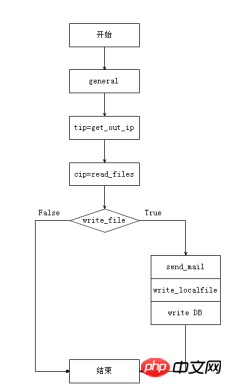 développement back-end
développement back-end
 Tutoriel Python
Tutoriel Python
 Exemple d'explication de l'obtention automatique d'une adresse IP publique en Python
Exemple d'explication de l'obtention automatique d'une adresse IP publique en Python
Exemple d'explication de l'obtention automatique d'une adresse IP publique en Python
Oct 09, 2017 am 10:40 AML'éditeur suivant vous apportera un exemple de la façon d'obtenir automatiquement une IP publique en Python. L'éditeur le trouve plutôt bon, je vais donc le partager avec vous maintenant et le donner comme référence pour tout le monde. Venez jeter un œil avec l'éditeur
0.1 SQL. Installation de base
ubuntu, série Debian :
Redhat, série Centos Installation :
1 |
|
Connectez-vous à la base de données
1 |
|
La syntaxe de création d'une base de données est la suivante
1 2 3 4 5 6 7 8 9 10 11 |
|
La syntaxe pour créer une table de données est la suivante
1 2 3 4 5 6 7 8 9 10 11 12 13 14 15 16 17 18 19 |
|
1 2 3 4 5 6 7 8 9 10 11 12 13 14 15 16 |
|
1 |
|
1 2 3 4 5 6 7 |
|
1 2 |
|
Chemin de téléchargement : https://pypi. python.org/pypi/MySQL-pythonInstallation :
Connecter Mysql1 2 3 4 5 6 7 8 9 10 11 |
|
1 2 3 4 5 6 7 8 9 10 11 |
|
1.1 Exigences
1 2 3 4 5 6 7 8 9 10 11 12 13 14 15 16 |
|
1.1 Exigences<. 🎜>Étant donné que le haut débit obtiendra une nouvelle IP à chaque redémarrage, alors dans cet état, il y aura beaucoup d'inconvénients lors de l'établissement d'une connexion SSH. Heureusement, il existait auparavant le logiciel Peanut Shell, qui. peut trouver votre adresse IP via le nom de domaine et y accéder. C'est le meilleur, mais récemment, Peanut Shell nécessite également de vrais noms. Il ne peut être utilisé qu'après authentification, cela m'a donc incité à écrire un script python pour obtenir l'adresse IP publique.
Effet de réussite : lorsque l'adresse IP change, une notification peut être envoyée par e-mail et les données peuvent être écrites dans la base de données 1.2
Idée générale
1.3
Organigramme
Les autres codes ne sont rien à dessiner
 2.
2.

2.1.1 Écrire du code python
getnetworkip.pysavedb .py
1 2 3 4 5 6 7 8 9 10 11 12 13 14 15 16 17 18 19 20 21 22 23 24 25 26 27 28 29 30 31 |
|
1 2 3 4 5 6 7 8 9 10 11 12 13 14 15 16 17 18 19 20 21 22 23 24 25 26 27 28 29 30 31 32 33 34 35 36 37 38 39 40 41 42 43 44 45 46 47 48 49 50 51 52 53 54 55 56 57 58 |
|
3 .Le effet
1 2 3 4 5 6 7 8 9 10 11 12 13 14 15 16 17 18 19 20 21 22 23 24 25 26 27 28 29 30 31 32 33 34 35 36 37 38 39 |
|
Utilisez SELECT pour visualiser le tableau, l'effet est le suivant :
Mettez le script dans crontab et laissez-le exécuter les tâches planifiées
Ce qui précède est le contenu détaillé de. pour plus d'informations, suivez d'autres articles connexes sur le site Web de PHP en chinois!

Article chaud

Outils chauds Tags

Article chaud

Tags d'article chaud

Bloc-notes++7.3.1
Éditeur de code facile à utiliser et gratuit

SublimeText3 version chinoise
Version chinoise, très simple à utiliser

Envoyer Studio 13.0.1
Puissant environnement de développement intégré PHP

Dreamweaver CS6
Outils de développement Web visuel

SublimeText3 version Mac
Logiciel d'édition de code au niveau de Dieu (SublimeText3)

Sujets chauds
 Quels sont les avantages et les inconvénients des modèles ?
May 08, 2024 pm 03:51 PM
Quels sont les avantages et les inconvénients des modèles ?
May 08, 2024 pm 03:51 PM
Quels sont les avantages et les inconvénients des modèles ?
 Google AI annonce Gemini 1.5 Pro et Gemma 2 pour les développeurs
Jul 01, 2024 am 07:22 AM
Google AI annonce Gemini 1.5 Pro et Gemma 2 pour les développeurs
Jul 01, 2024 am 07:22 AM
Google AI annonce Gemini 1.5 Pro et Gemma 2 pour les développeurs
 Pour seulement 250$, le directeur technique de Hugging Face vous apprend étape par étape comment peaufiner Llama 3
May 06, 2024 pm 03:52 PM
Pour seulement 250$, le directeur technique de Hugging Face vous apprend étape par étape comment peaufiner Llama 3
May 06, 2024 pm 03:52 PM
Pour seulement 250$, le directeur technique de Hugging Face vous apprend étape par étape comment peaufiner Llama 3
 Partagez plusieurs frameworks de projets open source .NET liés à l'IA et au LLM
May 06, 2024 pm 04:43 PM
Partagez plusieurs frameworks de projets open source .NET liés à l'IA et au LLM
May 06, 2024 pm 04:43 PM
Partagez plusieurs frameworks de projets open source .NET liés à l'IA et au LLM
 Un guide complet sur le débogage et l'analyse des fonctions Golang
May 06, 2024 pm 02:00 PM
Un guide complet sur le débogage et l'analyse des fonctions Golang
May 06, 2024 pm 02:00 PM
Un guide complet sur le débogage et l'analyse des fonctions Golang








